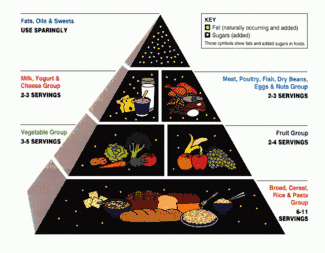Food pyramid
A food pyramid is a chart that can be used to see how many servings of each food should be eaten each day. It is for having good health.

The 1992 USDA food pyramid.
Grains give carbohydrates and some vitamins and minerals. Vegetables and fruits give a lot of vitamins, some minerals, and few fats, but fruits often have more calories and sugar. Dairy products (like milk, cheese, yogurt, etc.) have protein, some fat, and a lot of calcium, an element that helps build strong bones. Meat have protein, some fat, and B vitamins. Fats, oils, and sweets give calories, fats, and sugars but not a lot of nutrition.
Criticisms
The food pyramid has been criticized for recommending huge amounts of grains as that is a lot of carbohydrates.[1][2]
Related pages
References
- Brusie, Chaunie (2017-10-03). "How Did The Government Get The Food Pyramid So Terribly Wrong?". HealthyWay. Retrieved 2021-05-07.
- Willett, Meir J. Stampfer,Walter C. (2003). "Rebuilding the Food Pyramid". Scientific American. 288 (1): 64–71. doi:10.1038/scientificamerican0103-64. PMID 12506426. Retrieved 2021-05-07.
{{cite journal}}: CS1 maint: multiple names: authors list (link)
This article is issued from Wikipedia. The text is licensed under Creative Commons - Attribution - Sharealike. Additional terms may apply for the media files.